Intel Broadwell Architecture Preview: A Glimpse into Core M
by Ryan Smith on August 11, 2014 12:01 PM ESTPutting It All Together: Low Power Core M
So far we’ve discussed Broadwell’s architecture on a broad basis, focusing on features and optimizations that are fundamental to the architecture. However to talk about the Broadwell architecture is not enough to fully explain the Core M itself. Though many of Core M’s improvements do come from Broadwell, Intel has also made a number of alterations to everything from the CPU packaging to the process node itself specifically for Core M. It’s the resulting combination of these factors that has allowed Intel to iterate on Broadwell-Y over Haswell-Y, and why Intel is so confident in Broadwell-Y’s capabilities and suitability for mobile form factors.
When it comes to building and configuring Core M, Intel likes to refer to their efforts as the “Fanless Challenge,” reflecting the fact that their biggest goal with Core M is to comfortably get the processor in to 10” tablets under 10mm in thickness that are passively cooled. A big part of getting into such a device is meeting the heat dissipation limitations of the form factor – a 10” tablet under 10mm would require a sub-5W SoC – which is where a lot of Intel’s engineering efforts have gone. Broadwell’s performance optimizations, the GPU optimizations, GPU duty cycling, and the 14nm process all contribute to getting a Core CPU’s power consumption down to that level.
But even that’s still not enough, and for Core M Intel went so far as to give Broadwell-Y its own die and design a low-power optimized version of their 14nm process just for it. This variant is designed to further reduce power consumption by optimizing the resulting transistors for lower power, lower voltage, lower clockspeed operation. By doing this Intel was able to further reduce power consumption in all of the major areas over what would be a traditional 14nm Intel process.
In the resulting 14nm Broadwell-Y process, voltage, capacitance, and leakage were all improved over the traditional 14nm process. Capacitance was reduced by 15%, minimum operating voltages by 10%, and leakage was improved to the point that it reduced SoC power consumption by 10%. The combination of all of these factors serves to significantly lower power consumption over what Intel’s traditional 14nm process would provide.
Working in concert with Broadwell-Y’s 14nm process, Intel has made a number of other changes to further reduce power consumption. Some of these are reflected in Broadwell’s overall design and others are unique to Broadwell-Y, such as using a lower TjMax for Broadwell-Y. By reducing the maximum operating temperature of the chip Intel has been able to realize further power savings by further reducing voltage and decreasing the maximum amount of temperature-dependent leakage the SoC will experience.
Meanwhile Broadwell-Y’s partner in crime, the on-package PCH, has received its own optimizations to reduce power consumption on the SoC’s total power consumption. The PCH itself is not much of a power hog in the first place – it’s still made on Intel’s 32nm process for this and cost reasons – but with such a strong focus on power consumption every watt ends up counting. As a result the Broadwell PCH-LP has seen optimizations that cut its idle power consumption by 25% and its active power consumption by 20%. Further improvements to the PCH’s monitoring hardware also mean it’s more responsive and can be controlled to a finer degree than the Haswell PCH-LP, and Intel has upgraded to a faster audio DSP to improve performance and reduce power consumption there as well.
Feeding all of that silicon in turn is Intel’s second generation Fully Integrated Voltage Regulator (FIVR), which further builds off of Intel’s other optimizations. The 2nd gen FIVR has been tuned for Broadwell-Y’s lower voltages, making the FIVR itself more efficient when delivering power at those voltages. To accomplish this Intel has implemented non-linear vDroop control, which is designed to better control the voltage when workload changes would cause voltage overshoots that waste power. And when even the 2nd gen FIVR isn’t efficient enough, this latest FIVR offers a second mode (LVR Mode) for low voltage/workload situations where the FIVR can be partially bypassed to reduce the FIVR’s power consumption.
Interestingly Broadwell-Y also sees the voltage regulation inductors redesigned and relocated in both the name of power efficiency and space efficiency. We’ll get to the case of space efficiency in a moment, but for power efficiency the new 3D inductors (3DLs) have been placed on the underside of the package, allowing the use of more efficient inductors that waste less power.
This brings us to the final element of Intel’s power optimization efforts, which involve further adjustments to turbo boost as part of Intel’s “hurry up and go to sleep” motto. New for Broadwell-Y is a 3rd power state, PL3, which allows for even greater turbo boosting, but for only a very limited period of time – on the order of milliseconds. PL3 represents the maximum amount of power the device battery can deliver, and while it’s okay to reach this value sparingly, PL3 is a fast drain that is very hard on the battery. The existence of PL3 in this case is as much for battery protection as it is for performance; it allows devices to tap into PL3 power levels on occasion, all the while allowing PL2 (the regular burst limit) to be defined at a safer value below the battery’s limit. Put another way, by knowing PL3 devices know how to stay farther away from it, which in the long run is what’s best for battery reliability.


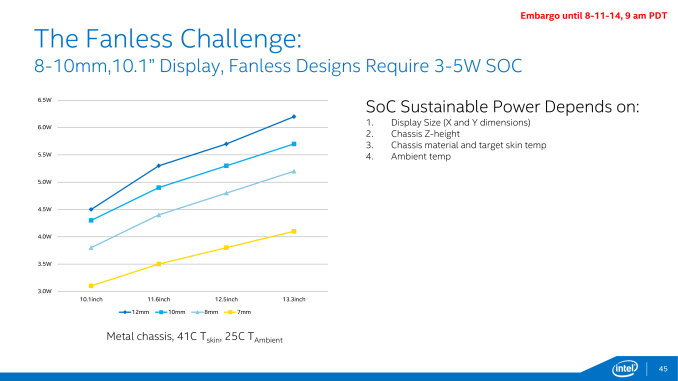
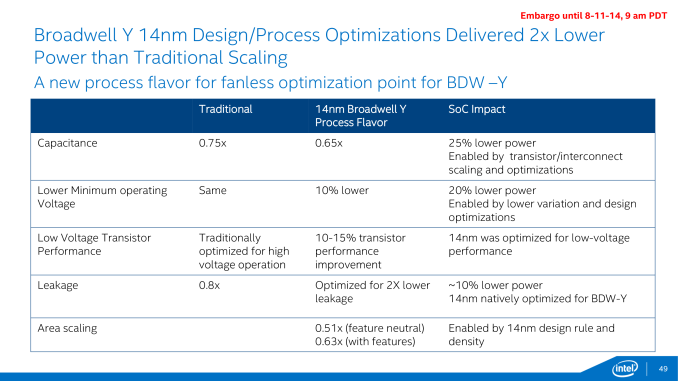
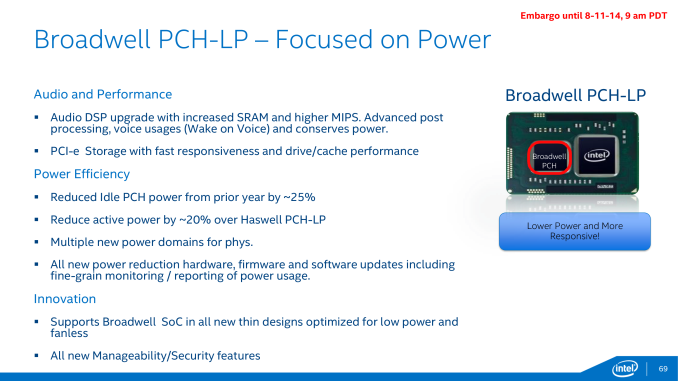
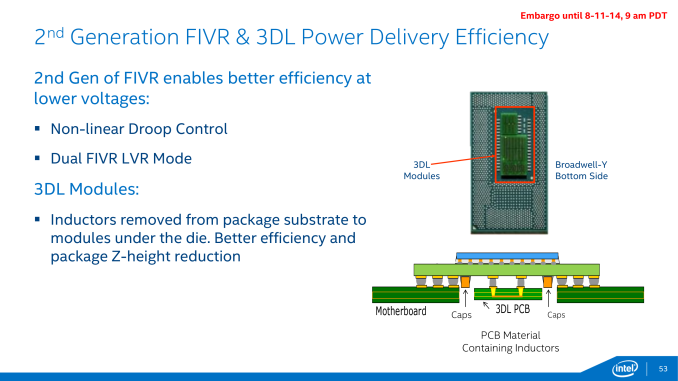

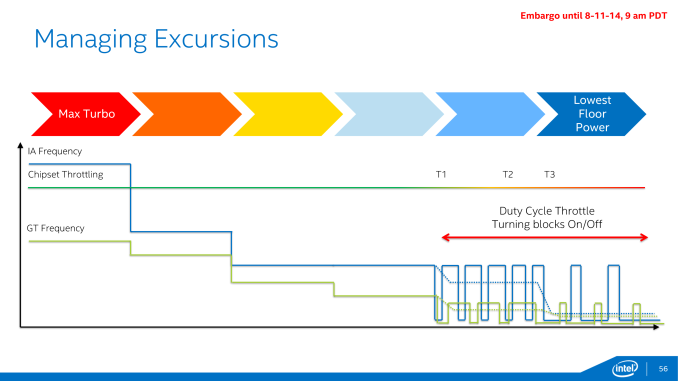








158 Comments
View All Comments
Krysto - Monday, August 11, 2014 - link
M stands for Mediocre. The main reason they are hitting those TDP levels is because they are reducing performance for those specific chips that they claim to use little power.I also bet Broadwell will jump even higher in price than Haswell, which also jumped 40 percent over IVB, considering they're having significant yield issues.
Grizzlebee - Monday, August 11, 2014 - link
I'm looking at prices right now on Newegg and there is a 5-10$ difference between Ivy Bridge and Sandy Bridge in price. Not even close to 40%.Krysto - Monday, August 11, 2014 - link
Original prices. Haswell is not the "mass market" chip for Intel, which means high volume, and can afford lower prices than initially, while IVB is low volume chip now, so it won't be much cheaper. Watch for when Broadwell comes out. It won't be just 10 percent more expensive than Haswell.bebimbap - Monday, August 11, 2014 - link
I believe Krysto was referring to the jump in prices from IB to HW, and not SB to IB.But either case, I'll have to disagree with Kyrsto. prices seems to have decreased over the years if anything. don't forget, because of IPC gains you are paying the same for more performance.
3570 = $210
4590 = $200
2320 = $190
3330 = $190
4430 = $180 w/ $10 off promo applied.
Gondalf - Monday, August 11, 2014 - link
All depends on from factor. If you want a tiny tablet, this is the only manner to do it.Or you do like Tegra K1 that scores 12W under full GPU operations??? Come on, put it in a slim convertible if you can.
HardwareDufus - Monday, August 11, 2014 - link
Pretty sure M stands for Mobile.Will be interesting to see what this means for Desktop variants. Want to see what improvements come the way of the GT3+ gpu.
gostan - Monday, August 11, 2014 - link
"and as we’ve seen with ARM based tablets so far they form a market that has continued to grow and continued to erode the x86 laptop market that Intel has dominated for so long."Is this your assumption or is it a fact? If the latter is true, can you provide some references?
Ryan Smith - Monday, August 11, 2014 - link
"If the latter is true, can you provide some references?"Sure.
http://www.gartner.com/newsroom/id/2647517
http://www.gartner.com/newsroom/id/2420816
Gartner regularly tracks PC unit sales, and tablets are regularly cited as a factor. On a more micro level, I know several people who have reduced their PC usage over the last couple of years (and delaed PC replacements) due to their tablet use.
Flunk - Monday, August 11, 2014 - link
http://www.forbes.com/sites/haydnshaughnessy/2014/...Tablet sales are falling too. Perhaps there is no relation at all and just an overall tightening due to the market maturing.
HanzNFranzen - Monday, August 11, 2014 - link
that doesn't seem to be the case.http://techcrunch.com/2014/07/06/gartner-device-sh...